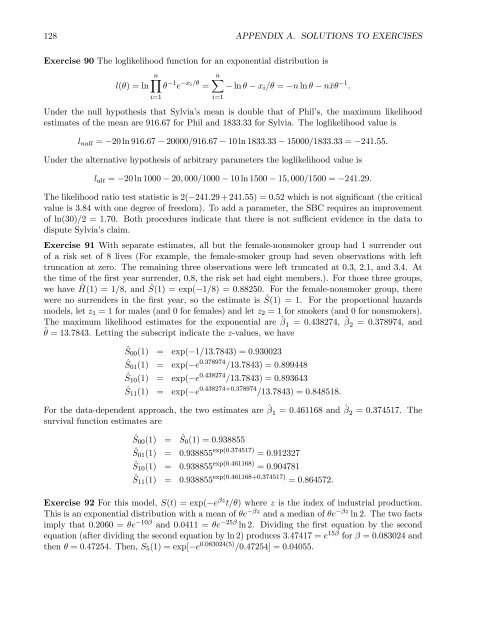Estimation, Evaluation, and Selection of Actuarial Models
Estimation, Evaluation, and Selection of Actuarial Models
Estimation, Evaluation, and Selection of Actuarial Models
Create successful ePaper yourself
Turn your PDF publications into a flip-book with our unique Google optimized e-Paper software.
128 APPENDIX A. SOLUTIONS TO EXERCISES<br />
Exercise 90 The loglikelihood function for an exponential distribution is<br />
l(θ) =ln<br />
nY<br />
θ −1 e −xi/θ =<br />
i=1<br />
nX<br />
− ln θ − x i /θ = −n ln θ − n¯xθ −1 .<br />
i=1<br />
Under the null hypothesis that Sylvia’s mean is double that <strong>of</strong> Phil’s, the maximum likelihood<br />
estimates <strong>of</strong> the mean are 916.67 for Phil <strong>and</strong> 1833.33 for Sylvia. The loglikelihood value is<br />
l null = −20 ln 916.67 − 20000/916.67 − 10 ln 1833.33 − 15000/1833.33 = −241.55.<br />
Under the alternative hypothesis <strong>of</strong> arbitrary parameters the loglikelihood value is<br />
l alt = −20 ln 1000 − 20, 000/1000 − 10 ln 1500 − 15, 000/1500 = −241.29.<br />
The likelihood ratio test statistic is 2(−241.29 + 241.55) = 0.52 which is not significant (the critical<br />
value is 3.84 with one degree <strong>of</strong> freedom). To add a parameter, the SBC requires an improvement<br />
<strong>of</strong> ln(30)/2 =1.70. Both procedures indicate that there is not sufficient evidence in the data to<br />
dispute Sylvia’s claim.<br />
Exercise 91 With separate estimates, all but the female-nonsmoker group had 1 surrender out<br />
<strong>of</strong> a risk set <strong>of</strong> 8 lives (For example, the female-smoker group had seven observations with left<br />
truncation at zero. The remaining three observations were left truncated at 0.3, 2.1, <strong>and</strong> 3.4. At<br />
the time <strong>of</strong> the first year surrender, 0.8, the risk set had eight members.). For those three groups,<br />
we have Ĥ(1) = 1/8, <strong>and</strong>Ŝ(1) = exp(−1/8) = 0.88250. For the female-nonsmoker group, there<br />
were no surrenders in the first year, so the estimate is Ŝ(1) = 1. For the proportional hazards<br />
models, let z 1 =1for males (<strong>and</strong> 0 for females) <strong>and</strong> let z 2 =1for smokers (<strong>and</strong> 0 for nonsmokers).<br />
The maximum likelihood estimates for the exponential are ˆβ 1 =0.438274, ˆβ 2 =0.378974, <strong>and</strong><br />
ˆθ =13.7843. Letting the subscript indicate the z-values, we have<br />
Ŝ 00 (1) = exp(−1/13.7843) = 0.930023<br />
Ŝ 01 (1) = exp(−e 0.378974 /13.7843) = 0.899448<br />
Ŝ 10 (1) = exp(−e 0.438274 /13.7843) = 0.893643<br />
Ŝ 11 (1) = exp(−e 0.438274+0.378974 /13.7843) = 0.848518.<br />
For the data-dependent approach, the two estimates are ˆβ 1 =0.461168 <strong>and</strong> ˆβ 2 =0.374517. The<br />
survival function estimates are<br />
Ŝ 00 (1) = Ŝ0(1) = 0.938855<br />
Ŝ 01 (1) = 0.938855 exp(0.374517) =0.912327<br />
Ŝ 10 (1) = 0.938855 exp(0.461168) =0.904781<br />
Ŝ 11 (1) = 0.938855 exp(0.461168+0.374517) =0.864572.<br />
Exercise 92 For this model, S(t) =exp(−e βz t/θ) where z is the index <strong>of</strong> industrial production.<br />
This is an exponential distribution with a mean <strong>of</strong> θe −βz <strong>and</strong> a median <strong>of</strong> θe −βz ln 2. Thetw<strong>of</strong>acts<br />
imply that 0.2060 = θe −10β <strong>and</strong> 0.0411 = θe −25β ln 2. Dividing the first equation by the second<br />
equation (after dividing the second equation by ln 2) produces 3.47417 = e 15β for β =0.083024 <strong>and</strong><br />
then θ =0.47254. Then, S 5 (1) = exp[−e 0.083024(5) /0.47254] = 0.04055.
















